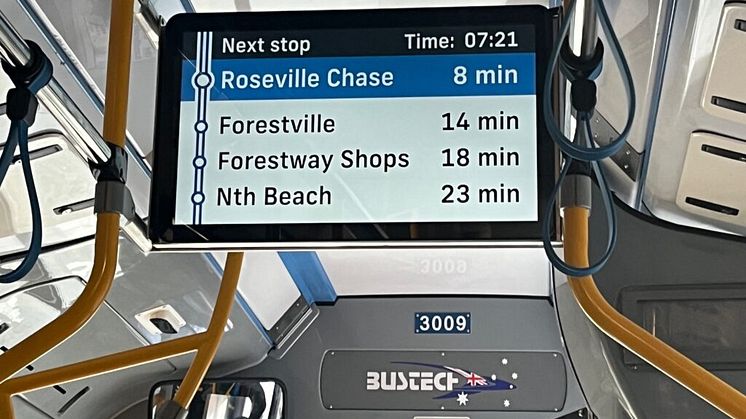
News -
Consat Telematics seeks to become transport glue for bus industry
Text by Sam Mortell, ABC Magazine, Busnews.com.au
A key part of Consat Telematics’ range since its inception in 1989 has been its capabilities in the passenger information systems sphere. The family owned company produces a range of passenger information solutions to keep transport patrons informed.
This global experience first arrived in Australia on November 26, 2017 when Consat brought its passenger information systems to New South Wales’ B-Line.
“The B-Line project is still running today, with real-time bus information systems still working onboard those buses without a hitch,” Consat Telematics Australian managing director Lachlan Mackay told ABC.
“Featuring announcements and real-time information, including the list of next stops, timings for stops and passenger announcements, this has been a great success to date.”
The B-Line was a brand new line of 40 double-decker buses servicing between Sydney’s Northern Beaches and the CBD, travelling over the famous Harbour Bridge and past the Opera House. It was the first line in Sydney to be equipped with a real-time passenger information systems, with a Public Information Display (PID) onboard the bus fleet.
With onboard PIDs and announcements continuing to run, it’s been a fast start for Consat’s passenger information systems in Australia.
“The B-Line has become the gold standard of passenger information systems onboard buses in Australia, we’re really proud of how it works,” Mackay says.
“Operators such as Keolis Downer have commented that the seamless reliable system effectively looks after itself, providing a low cost of ownership for operators.”
The B-Line passenger information systems have been a key part of Consat’s core offerings, running day-in, day-out for passengers to provide accurate information that automatically accounts for any cancellations or delays. The low-maintenance system is fully integrated with public transport authority’s datasets to run independently and autonomously.
Victorian operator Ventura Bus has also welcomed the technology onboard its network, while some Brisbane buses have began using the technology.
About a year ago, Consat took its next big step with its passenger information capabilities when it began putting its systems onboard the 160X bus service in Sydney. The 160X service is a high-capacity and high-frequency service running between the suburbs of Chatswood and Warringah.
While working with Transport for NSW (TfNSW), Consat provided a solution to increase passenger information, allowing more patrons to make decisions on how and when they travel. The out-of-the-box data driven solution, including an automatic import of PTO specific data, was implemented on 160X buses within a matter of weeks and has since automatically worked across every route in the operator’s area of service.
“The 160X system is essentially the same system but it was installed within a much shorter timeframe,” Mackay says.
“We can quickly add new buses and services to get crucial information to passengers very quickly. Whether it be audio and visual announcements for customers or other handy information for the operator, this has been a very successful project to date that works on any route, at any time and any where.”
The impact of the system’s ability to open up access was immediately put to the test through Consat’s very own Kurt Hennessy. As a visually impaired employee of the telematics company who also catches buses every day, Hennessy was able to work with TfNSW and other stakeholders to further enhance the 160X system.
“It can often be quite tricky to navigate buses, especially when in unfamiliar areas,” Hennessy told ABC.
“In these cases, I’ve had to rely on my phone to know my location, but even then I’ve had the odd case of missing a stop.
“This has been a great chance to advise and assist both TfNSW and our internal development team on items such as screen layouts and announcement behaviour in a way that provides a detailed but not overwhelming level of information to passengers, especially those with disabilities.”
Hennessy says a number of surveys have been conducted in the year since the 160X service installation to determine how the systems have helped passengers. He says the customer feedback on the service has been overwhelmingly positive.
Consat isn’t sitting back satisfied with its latest work in the passenger information sector. Mackay says that although the solution has helped drive improved access for a range of passengers, the system can also be used to increase the use of public transport.
Hennessy says Consat’s solution is the glue within a multi-modal transport system where its passenger information systems support passengers on any type of transport mode. Whether it be buses, ferries, trains or trams, or even the emerging active transport options of electric scooters and bikes, Consat Telematics has a solution.
“One thing we can do and haven’t used yet in Australia is the ability to show connecting services and integrate multi-modal trips,” Mackay says.
“Multi-modal has been at the core of our system from day one and, currently in Australia, transport modes run independently.
“We provide a solution that connects all modes of public transport and allows, for example, passengers to take both a bus and ferry and know if they will make their connections in real-time, or when alternate connections are available at the next stop. This is invaluable, particularly for older passengers and passengers travelling late at night.”
The solution works across all transport modes, with buses having real-time information of other linking transport services that can help get people to where they want to go as quickly as possible. This doesn’t just use timetables; it interacts with accurate forecasts of when the next services will be there to offer a nimble solution to the Australian transport challenge.
“The key is that passengers want to know when they get up how the system is running – if a bus is on time or if it’s full or if there’s major issues with the network, so that they can arrange other transport,” Mackay says.
“We’re intent on giving passengers information in real-time so that they can decide how they want to travel.
“Our main focus is looking at how we can add capabilities to our system and integrate them with data to provide a better journey with more options.”
If anyone can do this, Consat can. Integration is a major strength of what it can do in the passenger information game. With its history both globally and in Australia providing services for the public transport sector, don’t be surprised if the Consat glue solidifies quicker than expected.
“We want to be at the centre of transport and provide all the information that we can for passengers,” Hennessy says.


